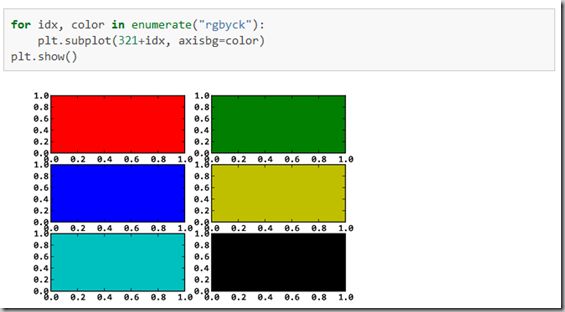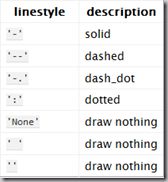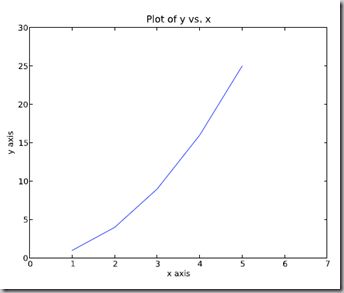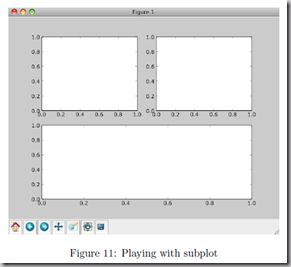matplotlib绘图库入门
matplotlib 是python最著名的绘图库,它提供了一整套和matlab相似的命令API,十分适合交互式地行制图。而且也可以方便地将它作为绘图控件,嵌入GUI应用程序中。
它的文档相当完备,并且Gallery页面中有上百幅缩略图,打开之后都有源程序。因此如果你需要绘制某种类型的图,只需要在这个页面中浏览/复制/粘贴一下,基本上都能搞定。
在Linux下比较著名的数据图工具还有gnuplot,这个是免费的,Python有一个包可以调用gnuplot,但是语法比较不习惯,而且画图质量不高。
而 Matplotlib则比较强:Matlab的语法、python语言、latex的画图质量(还可以使用内嵌的latex引擎绘制的数学公式)。
Matplotlib.pyplot快速绘图
快速绘图和面向对象方式绘图
matplotlib实际上是一套面向对象的绘图库,它所绘制的图表中的每个绘图元素,例如线条Line2D、文字Text、刻度等在内存中都有一个对象与之对应。
为了方便快速绘图matplotlib通过pyplot模块提供了一套和MATLAB类似的绘图API,将众多绘图对象所构成的复杂结构隐藏在这套API内部。我们只需要调用pyplot模块所提供的函数就可以实现快速绘图以及设置图表的各种细节。pyplot模块虽然用法简单,但不适合在较大的应用程序中使用。
为了将面向对象的绘图库包装成只使用函数的调用接口,pyplot模块的内部保存了当前图表以及当前子图等信息。当前的图表和子图可以使用plt.gcf()和plt.gca()获得,分别表示"Get Current Figure"和"Get Current Axes"。在pyplot模块中,许多函数都是对当前的Figure或Axes对象进行处理,比如说:
plt.plot()实际上会通过plt.gca()获得当前的Axes对象ax,然后再调用ax.plot()方法实现真正的绘图。
可以在Ipython中输入类似"plt.plot??"的命令查看pyplot模块的函数是如何对各种绘图对象进行包装的。
配置属性
matplotlib所绘制的图表的每个组成部分都和一个对象对应,我们可以通过调用这些对象的属性设置方法set_*()或者pyplot模块的属性设置函数setp()设置它们的属性值。
因为matplotlib实际上是一套面向对象的绘图库,因此也可以直接获取对象的属性
配置文件
绘制一幅图需要对许多对象的属性进行配置,例如颜色、字体、线型等等。我们在绘图时,并没有逐一对这些属性进行配置,许多都直接采用了matplotlib的缺省配置。
matplotlib将这些缺省配置保存在一个名为“matplotlibrc”的配置文件中,通过修改配置文件,我们可以修改图表的缺省样式。配置文件的读入可以使用rc_params(),它返回一个配置字典;在matplotlib模块载入时会调用rc_params(),并把得到的配置字典保存到rcParams变量中;matplotlib将使用rcParams字典中的配置进行绘图;用户可以直接修改此字典中的配置,所做的改变会反映到此后创建的绘图元素。
绘制多子图(快速绘图)
Matplotlib 里的常用类的包含关系为 Figure -> Axes -> (Line2D, Text, etc.)一个Figure对象可以包含多个子图(Axes),在matplotlib中用Axes对象表示一个绘图区域,可以理解为子图。
可以使用subplot()快速绘制包含多个子图的图表,它的调用形式如下:
subplot(numRows, numCols, plotNum)
subplot将整个绘图区域等分为numRows行* numCols列个子区域,然后按照从左到右,从上到下的顺序对每个子区域进行编号,左上的子区域的编号为1。如果numRows,numCols和plotNum这三个数都小于10的话,可以把它们缩写为一个整数,例如subplot(323)和subplot(3,2,3)是相同的。subplot在plotNum指定的区域中创建一个轴对象。如果新创建的轴和之前创建的轴重叠的话,之前的轴将被删除。
subplot()返回它所创建的Axes对象,我们可以将它用变量保存起来,然后用sca()交替让它们成为当前Axes对象,并调用plot()在其中绘图。
绘制多图表(快速绘图)
如果需要同时绘制多幅图表,可以给figure()传递一个整数参数指定Figure对象的序号,如果序号所指定的Figure对象已经存在,将不创建新的对象,而只是让它成为当前的Figure对象。
import numpy as npimport matplotlib.pyplot as pltplt.figure(1) # 创建图表1plt.figure(2) # 创建图表2ax1 = plt.subplot(211) # 在图表2中创建子图1ax2 = plt.subplot(212) # 在图表2中创建子图2x = np.linspace(0, 3, 100)for i in xrange(5): plt.figure(1) #❶ # 选择图表1 plt.plot(x, np.exp(i*x/3)) plt.sca(ax1) #❷ # 选择图表2的子图1 plt.plot(x, np.sin(i*x)) plt.sca(ax2) # 选择图表2的子图2 plt.plot(x, np.cos(i*x))plt.show()
在图表中显示中文
matplotlib的缺省配置文件中所使用的字体无法正确显示中文。为了让图表能正确显示中文,可以有几种解决方案。
在程序中直接指定字体。
在程序开头修改配置字典rcParams。
修改配置文件。
面向对象画图
matplotlib API包含有三层,Artist层处理所有的高层结构,例如处理图表、文字和曲线等的绘制和布局。通常我们只和Artist打交道,而不需要关心底层的绘制细节。
直接使用Artists创建图表的标准流程如下:
创建Figure对象
用Figure对象创建一个或者多个Axes或者Subplot对象
调用Axies等对象的方法创建各种简单类型的Artists
import matplotlib.pyplot as pltX1 = range(0, 50)Y1 = [num**2 for num in X1] # y = x^2X2 = [0, 1]Y2 = [0, 1] # y = xFig = plt.figure(figsize=(8,4)) # Create a `figure' instanceAx = Fig.add_subplot(111) # Create a `axes' instance in the figureAx.plot(X1, Y1, X2, Y2) # Create a Line2D instance in the axesFig.show()Fig.savefig("test.pdf")
参考:
《Python科学计算》(Numpy视频) matplotlib-绘制精美的图表(快速绘图)(面向对象绘图)(深入浅出适合系统学习)
什么是 Matplotlib (主要讲面向对象绘图,对于新手可能有点乱)
Matplotlib.pylab快速绘图
matplotlib还提供了一个名为pylab的模块,其中包括了许多NumPy和pyplot模块中常用的函数,方便用户快速进行计算和绘图,十分适合在IPython交互式环境中使用。这里使用下面的方式载入pylab模块:
>>> import pylab as pl
1 安装numpy和matplotlib
>>> import numpy
>>> numpy.__version__
>>> import matplotlib
>>> matplotlib.__version__
2 两种常用图类型:Line and scatter plots(使用plot()命令), histogram(使用hist()命令)
2.1 折线图&散点图 Line and scatter plots
2.1.1 折线图 Line plots(关联一组x和y值的直线)
import numpy as npimport pylab as plx = [1, 2, 3, 4, 5]# Make an array of x valuesy = [1, 4, 9, 16, 25]# Make an array of y values for each x valuepl.plot(x, y)# use pylab to plot x and ypl.show()# show the plot on the screen
2.1.2 散点图 Scatter plots
把pl.plot(x, y)改成pl.plot(x, y, 'o')即可,下图的蓝色版本
2.2 美化 Making things look pretty
2.2.1 线条颜色 Changing the line color
红色:把pl.plot(x, y, 'o')改成pl.plot(x, y, ’or’)
2.2.2 线条样式 Changing the line style
虚线:plot(x,y, '--')
2.2.3 marker样式 Changing the marker style
蓝色星型markers:plot(x,y, ’b*’)
2.2.4 图和轴标题以及轴坐标限度 Plot and axis titles and limits
import numpy as npimport pylab as plx = [1, 2, 3, 4, 5]# Make an array of x valuesy = [1, 4, 9, 16, 25]# Make an array of y values for each x valuepl.plot(x, y)# use pylab to plot x and ypl.title(’Plot of y vs. x’)# give plot a titlepl.xlabel(’x axis’)# make axis labelspl.ylabel(’y axis’)pl.xlim(0.0, 7.0)# set axis limitspl.ylim(0.0, 30.)pl.show()# show the plot on the screen
2.2.5 在一个坐标系上绘制多个图 Plotting more than one plot on the same set of axes
做法是很直接的,依次作图即可:
import numpy as npimport pylab as plx1 = [1, 2, 3, 4, 5]# Make x, y arrays for each graphy1 = [1, 4, 9, 16, 25]x2 = [1, 2, 4, 6, 8]y2 = [2, 4, 8, 12, 16]pl.plot(x1, y1, ’r’)# use pylab to plot x and ypl.plot(x2, y2, ’g’)pl.title(’Plot of y vs. x’)# give plot a titlepl.xlabel(’x axis’)# make axis labelspl.ylabel(’y axis’)pl.xlim(0.0, 9.0)# set axis limitspl.ylim(0.0, 30.)pl.show()# show the plot on the screen
2.2.6 图例 Figure legends
pl.legend((plot1, plot2), (’label1, label2’), 'best’, numpoints=1)
其中第三个参数表示图例放置的位置:'best’‘upper right’, ‘upper left’, ‘center’, ‘lower left’, ‘lower right’.
如果在当前figure里plot的时候已经指定了label,如plt.plot(x,z,label="$cos(x^2)$"),直接调用plt.legend()就可以了哦。
import numpy as npimport pylab as plx1 = [1, 2, 3, 4, 5]# Make x, y arrays for each graphy1 = [1, 4, 9, 16, 25]x2 = [1, 2, 4, 6, 8]y2 = [2, 4, 8, 12, 16]plot1 = pl.plot(x1, y1, ’r’)# use pylab to plot x and y : Give your plots namesplot2 = pl.plot(x2, y2, ’go’)pl.title(’Plot of y vs. x’)# give plot a titlepl.xlabel(’x axis’)# make axis labelspl.ylabel(’y axis’)pl.xlim(0.0, 9.0)# set axis limitspl.ylim(0.0, 30.)pl.legend([plot1, plot2], (’red line’, ’green circles’), ’best’, numpoints=1)# make legendpl.show()# show the plot on the screen
2.3 直方图 Histograms
import numpy as npimport pylab as pl# make an array of random numbers with a gaussian distribution with# mean = 5.0# rms = 3.0# number of points = 1000data = np.random.normal(5.0, 3.0, 1000)# make a histogram of the data arraypl.hist(data)# make plot labelspl.xlabel(’data’)pl.show()
如果不想要黑色轮廓可以改为pl.hist(data, histtype=’stepfilled’)
2.3.1 自定义直方图bin宽度 Setting the width of the histogram bins manually
增加这两行
bins = np.arange(-5., 16., 1.) #浮点数版本的range
pl.hist(data, bins, histtype=’stepfilled’)
3 同一画板上绘制多幅子图 Plotting more than one axis per canvas
如果需要同时绘制多幅图表的话,可以是给figure传递一个整数参数指定图标的序号,如果所指定
序号的绘图对象已经存在的话,将不创建新的对象,而只是让它成为当前绘图对象。
fig1 = pl.figure(1)
pl.subplot(211)
subplot(211)把绘图区域等分为2行*1列共两个区域, 然后在区域1(上区域)中创建一个轴对象. pl.subplot(212)在区域2(下区域)创建一个轴对象。
You can play around with plotting a variety of layouts. For example, Fig. 11 is created using the following commands:
f1 = pl.figure(1)
pl.subplot(221)
pl.subplot(222)
pl.subplot(212)
当绘图对象中有多个轴的时候,可以通过工具栏中的Configure Subplots按钮,交互式地调节轴之间的间距和轴与边框之间的距离。如果希望在程序中调节的话,可以调用subplots_adjust函数,它有left, right, bottom, top, wspace, hspace等几个关键字参数,这些参数的值都是0到1之间的小数,它们是以绘图区域的宽高为1进行正规化之后的坐标或者长度。
pl.subplots_adjust(left=0.08, right=0.95, wspace=0.25, hspace=0.45)
4 绘制文件中的数据Plotting data contained in files
4.1 从Ascii文件中读取数据 Reading data from ascii files
读取文件的方法很多,这里只介绍一种简单的方法,更多的可以参考官方文档和NumPy快速处理数据(文件存取)。
numpy的loadtxt方法可以直接读取如下文本数据到numpy二维数组
**********************************************
# fakedata.txt
0 0
1 1
2 4
3 9
4 16
5 25
6 36
7 49
8 64
9 81
0 0
1 1
2 4
3 9
4 16
5 25
6 36
7 49
8 64
9 81
**********************************************
import numpy as npimport pylab as pl# Use numpy to load the data contained in the file# ’fakedata.txt’ into a 2-D array called datadata = np.loadtxt(’fakedata.txt’)# plot the first column as x, and second column as ypl.plot(data[:,0], data[:,1], ’ro’)pl.xlabel(’x’)pl.ylabel(’y’)pl.xlim(0.0, 10.)pl.show()
4.2 写入数据到文件 Writing data to a text file
写文件的方法也很多,这里只介绍一种可用的写入文本文件的方法,更多的可以参考官方文档。
import numpy as np# Let’s make 2 arrays (x, y) which we will write to a file# x is an array containing numbers 0 to 10, with intervals of 1x = np.arange(0.0, 10., 1.)# y is an array containing the values in x, squaredy = x*xprint ’x = ’, xprint ’y = ’, y# Now open a file to write the data to# ’w’ means open for ’writing’file = open(’testdata.txt’, ’w’)# loop over each line you want to write to filefor i in range(len(x)): # make a string for each line you want to write # ’\t’ means ’tab’ # ’\n’ means ’newline’ # ’str()’ means you are converting the quantity in brackets to a string type txt = str(x[i]) + ’\t’ + str(y[i]) + ’ \n’ # write the txt to the file file.write(txt)# Close your filefile.close()
这部分是翻译自:Python Plotting Beginners Guide
对LaTeX数学公式的支持
Matlplotlib对LaTeX有一定的支持,如果记得使用raw字符串语法会很自然:
xlabel(r"$\frac{x^2}{y^4}$")
在matplotlib里面,可以使用LaTex的命令来编辑公式,只需要在字符串前面加一个“r”即可
Here is a simple example:
# plain text
plt.title('alpha > beta')
produces “alpha > beta”.
Whereas this:
# math text
plt.title(r'$\alpha > \beta$')
produces "![]() ".
".
这里给大家看一个简单的例子。
import matplotlib.pyplot as plt
x = arange(1,1000,1)
r = -2
c = 5
y = [5*(a**r) for a in x]
fig = plt.figure()
ax = fig.add_subplot(111)
ax.loglog(x,y,label = r"$y = \frac{1}{2\sigma_1^2}, c=5,\sigma_1=-2$")
ax.legend()
ax.set_xlabel(r"x")
ax.set_ylabel(r"y")
程序执行结果如图3所示,这实际上是一个power-law的例子,有兴趣的朋友可以继续google之。
再看一个《用Python做科学计算》中的简单例子,下面的两行程序通过调用plot函数在当前的绘图对象中进行绘图:
plt.plot(x,y,label="$sin(x)$",color="red",linewidth=2)
plt.plot(x,z,"b--",label="$cos(x^2)$")
plot函数的调用方式很灵活,第一句将x,y数组传递给plot之后,用关键字参数指定各种属性:
label : 给所绘制的曲线一个名字,此名字在图示(legend)中显示。只要在字符串前后添加"$"符号,matplotlib就会使用其内嵌的latex引擎绘制的数学公式。
color : 指定曲线的颜色
linewidth : 指定曲线的宽度
详细的可以参考matplotlib官方教程:
Writing mathematical expressions
Subscripts and superscripts
Fractions, binomials and stacked numbers
Radicals
Fonts
Custom fonts
Accents
Symbols
Example
Text rendering With LaTeX
usetex with unicode
Postscript options
Possible hangups
Troubleshooting
有几个问题:
matplotlib.rcParams属性字典
想要它正常工作,在matplotlibrc配置文件中需要设置text.markup = "tex"。
如果你希望图表中所有的文字(包括坐标轴刻度标记)都是LaTeX'd,需要在matplotlibrc中设置text.usetex = True。如果你使用LaTeX撰写论文,那么这一点对于使图表和论文中其余部分保持一致是很有用的。
在matplotlib中使用中文字符串时记住要用unicode格式,例如:u''测试中文显示''
matplotlib使用小结













